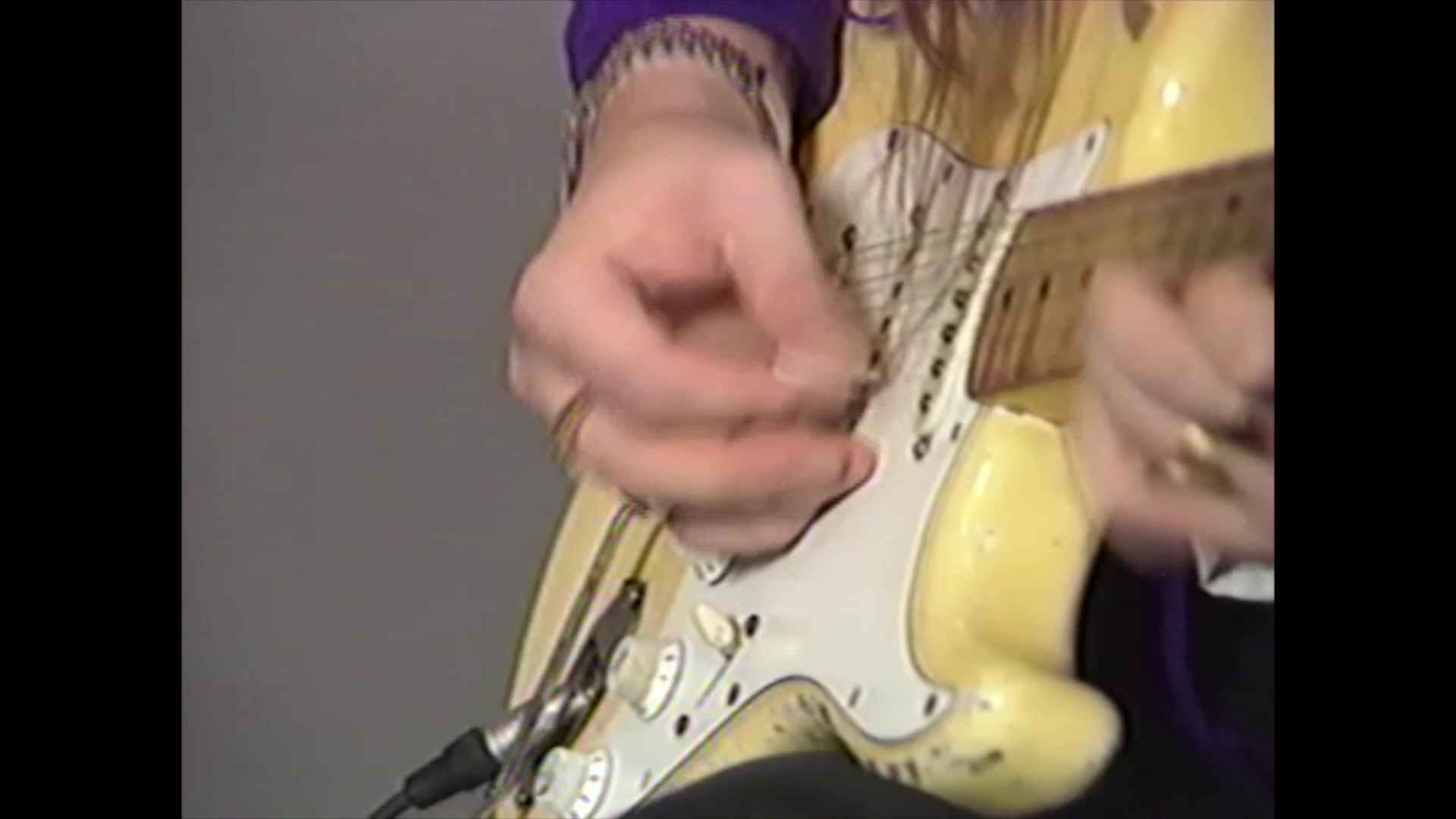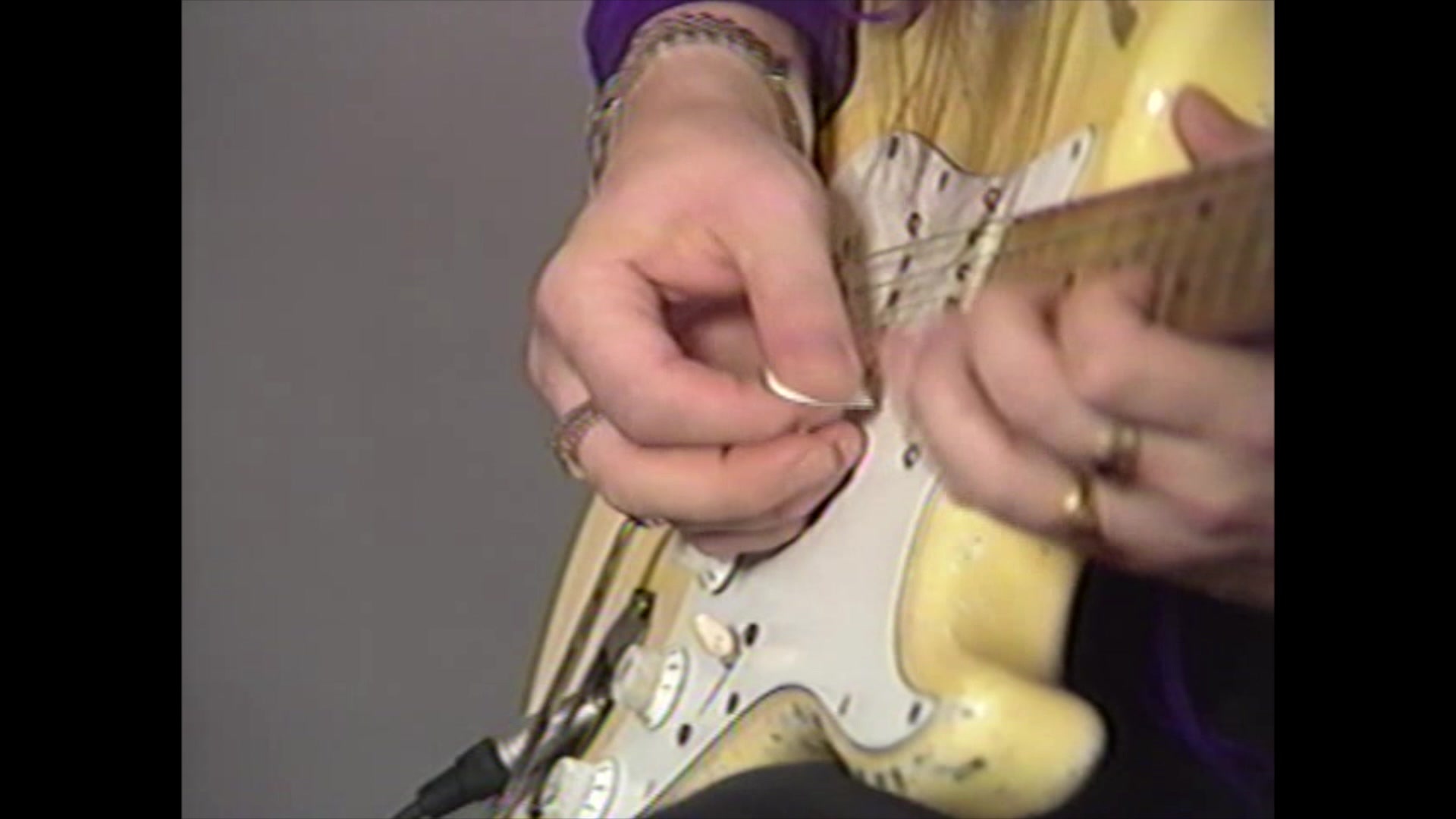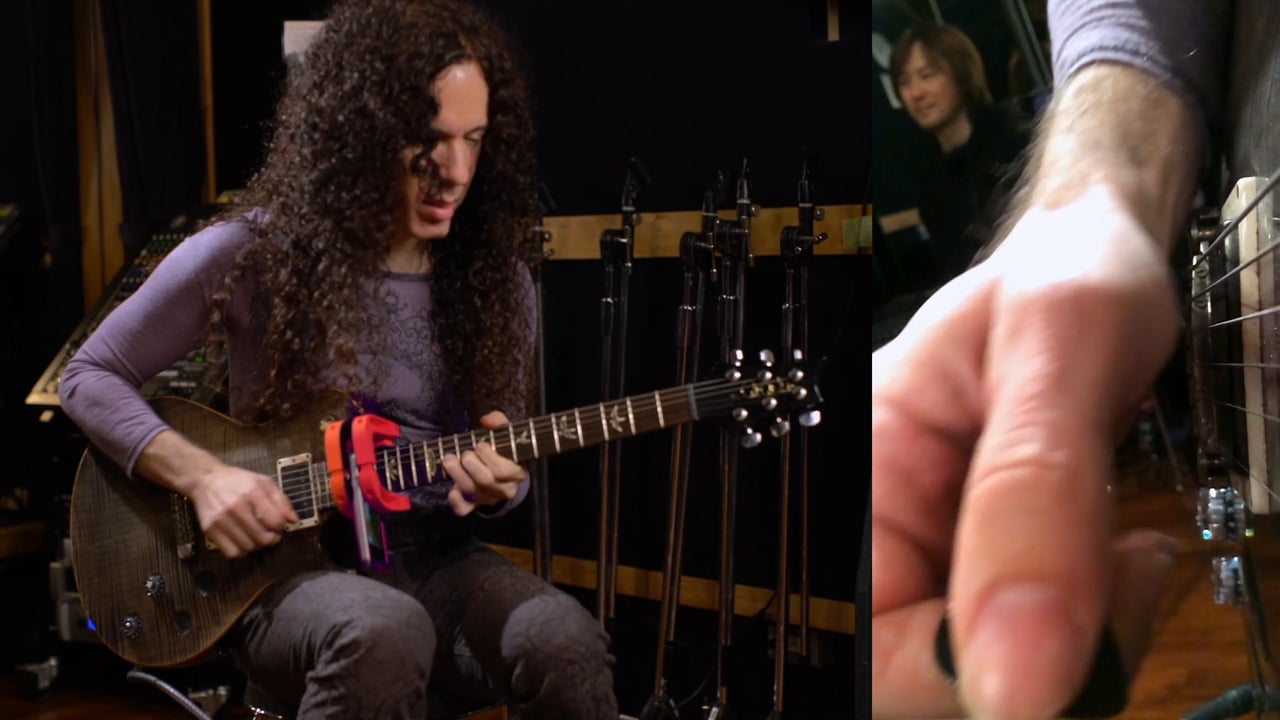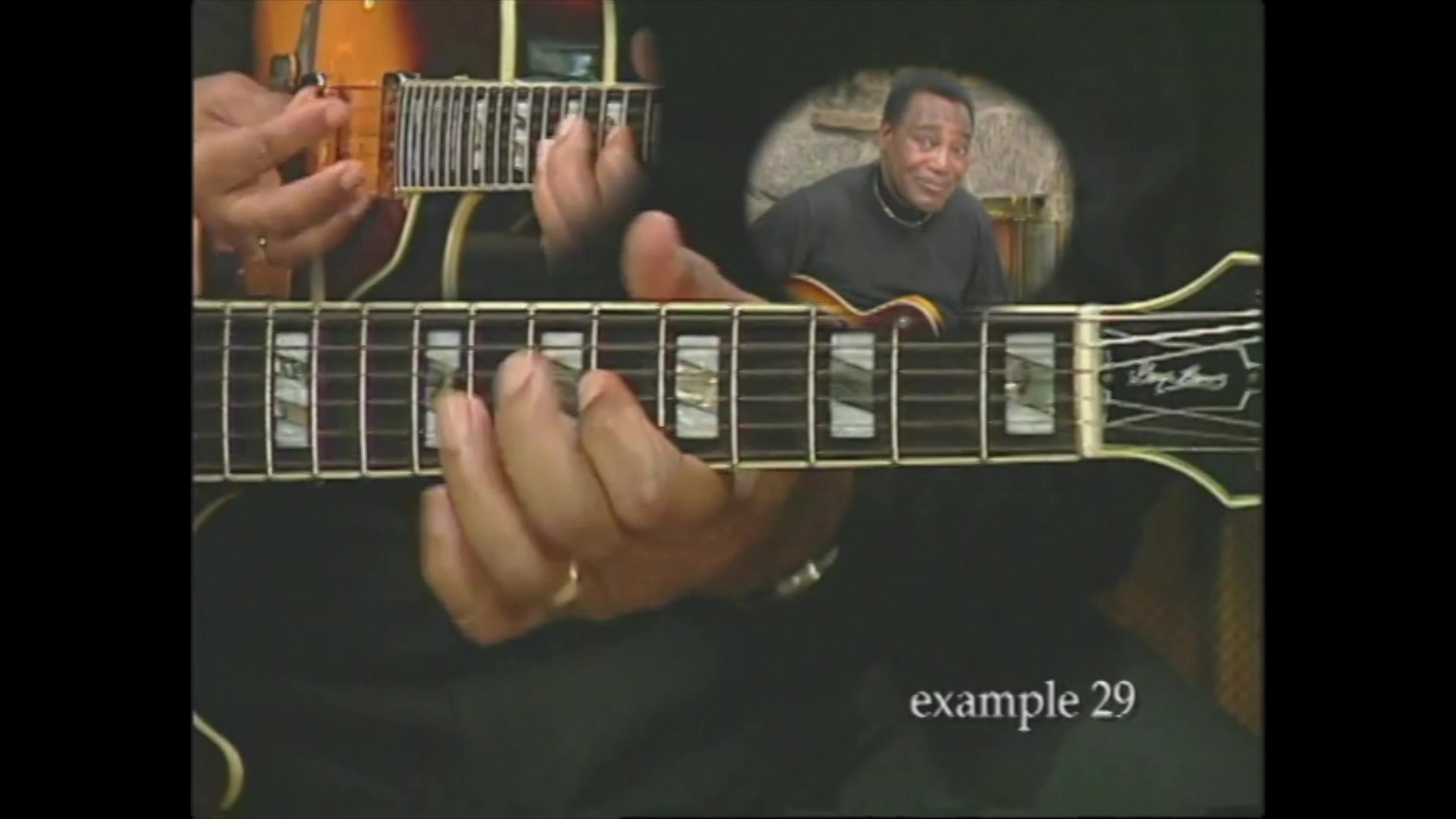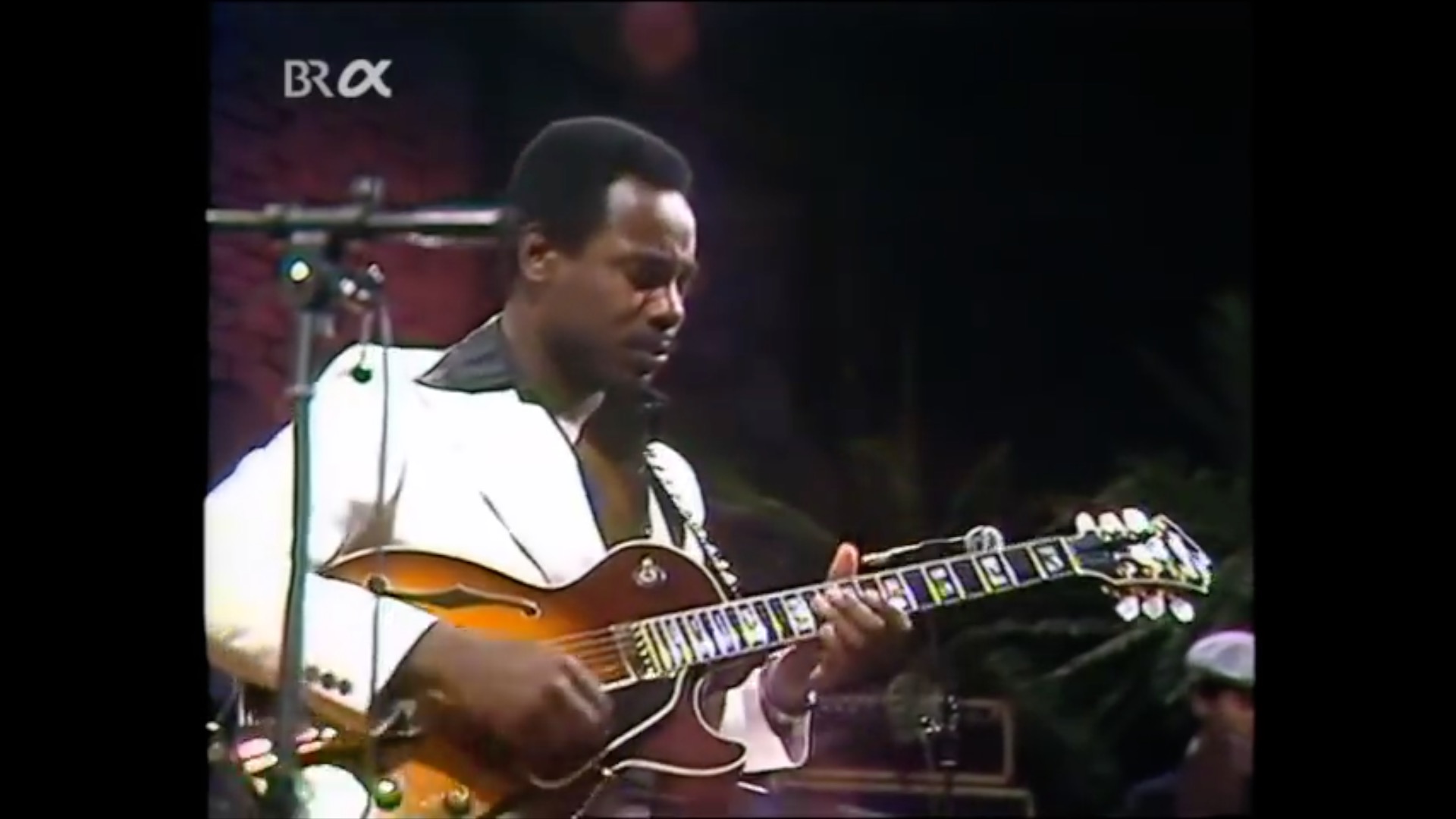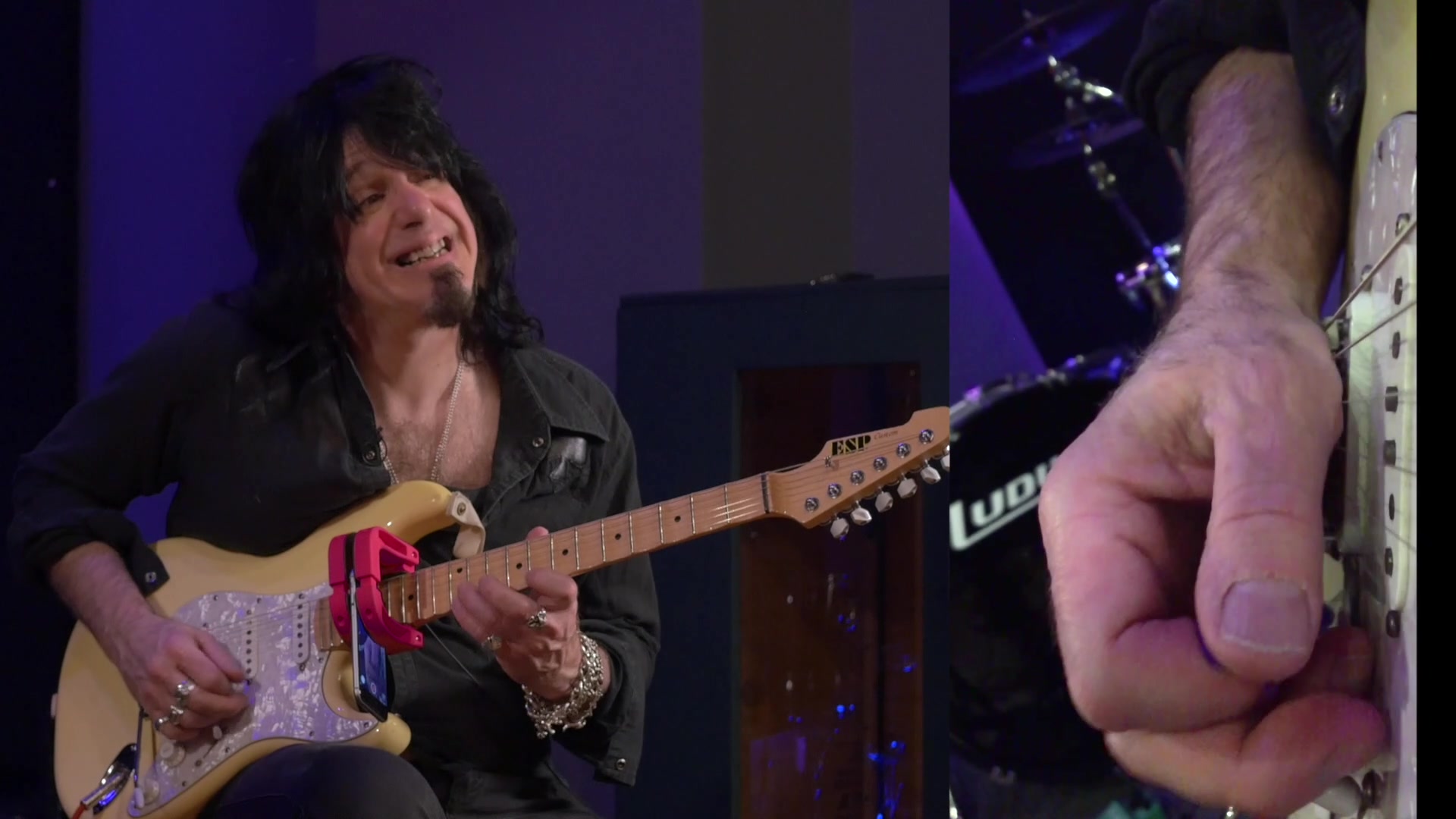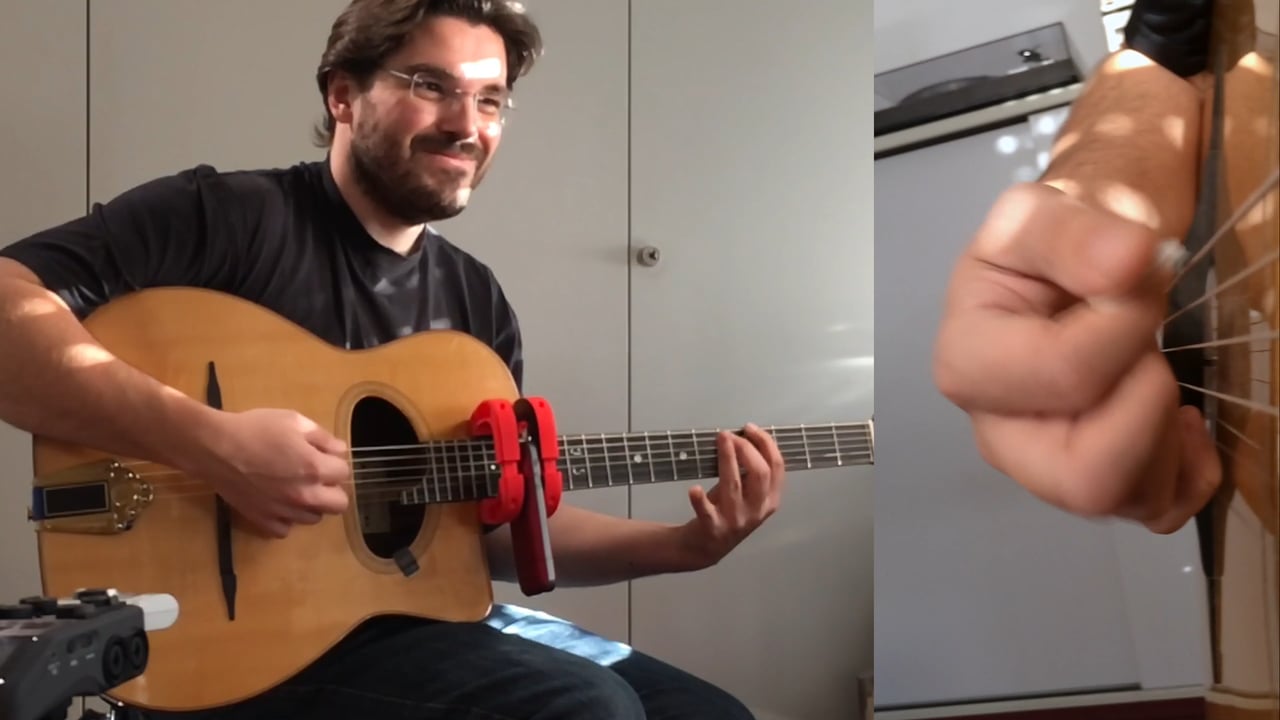DWPS Economy
Combining USX motion, downstroke sweeping and downward pickslanting creates one of the most popular picking styles of all time.
By now we’ve examined different ways you can create USX picking motion. And we’ve also looked at the mechanics of how pickslanting and sweeping can work together. When you combine these three ingredients, you arrive at one of the most widely-used picking styles in guitar: downward pickslanting economy.
DWPS economy is a one-way economy picking style because it utilizes a single direction of sweeping — the downstroke sweep — to economize specific string changes. So in the DWPS economy style, sweeps only move in one direction, but alternate picking can move in both directions, provided the final pickstroke on each string is an upstroke.
Because USX alternate picking and downstroke sweeping are the only two motions available to DWPS economy players, phrases may require certain notes to be played with specific pickstrokes, to be left unpicked, or in certain cases to be removed entirely in order to maintain efficiency at high speed. This results in a set of similarities in the way DWPS economy phrases are structured that are consistent across players and musical genres.
USX Motion
In the DPWS economy system, USX motion supplies the primary continuous alternate picking motion. When paired with phrases that contain an even number of notes on every string, string changes are possible even at very high speed with no mechanical penalty:
Alternate Picking - Six-Note Pattern - Connected

This common six-note pattern is a staple of single-escape picking thanks to its even-numbered groupings. When started on a downstroke as it is in this example, each upstroke rises into the escape zone, making for easy transition to the next lower string.
Even though the first half of this phrase occurs entirely on the E string, USX motion is maintained the entire way, so escape motion is generated even though it’s technically not necessary. There is no mechanical “cost” to doing this, since single escape picking motions are already about as simple as a picking motion gets. But there is benefit in that no change to the motion itself is necessary beyond simply relocating it to the desired string.
Downstroke Sweeping
Picking pioneer Yngwie Malmsteen is remarkably consistent in applying DWPS economy to his vocabulary of classically-inspired scales and arpeggios, and his signature phrases offer many illustrative examples of one-way economy design at work.
While Yngwie’s use of sweeping for arpeggio playing generated immediate interest in sweep technique in rock guitar, what was less known at the time was the critical role sweeping played in Yngwie’s scalar technique. In this example from his REH instructional video, Yngwie sequences a 10-note circular pattern through successive positions on the top two strings:
Given the blazing speed of this phrase, it’s not obvious upon first listen that sweeping figures prominently in its execution. But slowing it down makes this particular economy component clearer. Let’s take a look at just the first iteration of the sequence:
Yngwie plays three notes on the B string, the third of which is actually a downstroke sweep that is also responsible for the first picked note on the E string. The sweep is necessary here because downstrokes are trapped in USX motion, and can only switch strings through sweeping — and only then when moving to a higher string. In this case, that works out conveniently, as the third downstroke of the phrase can simply push through to the next string:

So sweeping in the DWPS economy system isn’t just economical, it’s structural. While there is no doubt mechanical savings in allowing a trapped pickstroke to play more than one note, the real reason it’s being used here is because it is the only string switching option available. This has the significant benefit of simplifying the motions needed to play a notoriously complex sequence like a three-note-per-string scale.
In this sense, using the term “economy” to describe this approach is a little misleading, because it implies that playing these notes another way would simply require more work. But physical labor isn’t the problem — it’s complexity. We know that it’s possible to play scales efficiently with pure alternate picking, but we also know that relatively few players seem to do it well. So rather than making scales more economical, the primary benefit of Yngwie’s DWPS economy approach is that it makes the picking motions easier to figure out, with less trial and error.
Legato and Forced Upstrokes
The return string change highlights the specific role that unpicked or legato notes play in DWPS economy technique. Counting the tail end of the initial downstroke sweep, the complete picking sequence on the top string of the lick is down, up, down, up — one pickstroke short of the number of notes on the top string. So the fifth and final note on the string isn’t picked at all, but instead pulled off:

Like Yngwie’s use of sweeping for the first string change, the choice to leave the final note on the string unpicked is essentially predetermined by the available motions. If the note were picked, it would be a downstroke. And since downstrokes are trapped, they can’t switch strings. Conversely, there’s no way to make the last note an upstroke, since the previous pickstroke was already an upstroke and we can’t do two in a row. So the only remaining choice is to simply not pick the note at all.
Using either a pull-off or hammer-on as the final note on the string is a very common DWPS economy technique for ensuring the final picked note on a given string is an upstroke. In this example, this converts the number of pickstrokes on the string from odd to even, allowing Yngwie to return to the lower string using an escaped upstroke for maximum string-switching efficiency.
Fretboard Refactoring
Yngwie’s final mechanical tweak concerns the symmetry of the phrase itself. Specifically, the sequence ends with only two notes on the B string, omitting the middle note of the three-note fingering that he played on the way up:

Even though this results in the phrase having a metrically unusual total of ten notes, this seemingly unorthodox choice is once again grounded in mechanics. Much like his use of pulloffs, this is Yngwie’s way of forcing the final note of the sequence to be an upstroke. This ensures that the next iteration of the sequence will begin on a downstroke, maintaining the carefully constructed alignment of sweeping, pull-offs, and upstrokes that make its string changes work so efficiently even at these very high speeds.
The DDU Sequence
Another great example of these design considerations at work is a picking sequence that plays a critical role in many DWPS economy phrases: DDU. In the DDU sequence, a downstroke sweeps across two strings followed by an upstroke on the higher string. The DDU pattern provides a mechanically streamlined way of tackling what is ordinarly a challenging situation for alternate picking, namely a single note on a string by itself.
Fusion pioneer Eric Johnson’s famous five-note pattern, which Eric uses as a core building block in his vocabulary of pentatonic phrases, is a classic demonstration of DDU in action:
In Eric’s five-note pattern, he plays four notes with USX motion, using the upstrokes to switch strings each time. He then connects the fifth note of the pattern back to the first note with a single downstroke sweep that plays both notes:

USX escaped upstrokes take care of the fast string changes on the first two strings of the pattern, and sweeping handles the fifth note of the sequence, located on a string by itself. So the sweep not only plays the last note, but also the first note of the next iteration of the pattern. This ensures that the pattern always starts on a downstroke, setting up the proper sequence of pickstrokes to enable the upstroke string changes and sweeping to work as intended on all subsequent iterations of the pattern.
Just as it does with Yngwie’s scale pattern, DWPS economy solves what would otherwise be a challenging mechanical puzzle, allowing Eric to play this pattern quickly with high reliability and few errors, even at this rate of speed. In fact, it is notable that Eric’s five-note pattern is a common one among DWPS economy players, while it has remained uncommon in the vocabularies of even very good pure alternate players. This is not to say that the phrase can’t be played with alternate picking, but only that the challenge of figuring out the correct motions may make it less likely for pure alternate players to try. By comparison, the fact that its structure aligns well with common DWPS economy picking patterns may simply make it more likely to be discovered and mastered by those players, even if they didn’t specifically set out to do so.
The Primary DWPS Economy Style
Despite its simple mechanical vocabulary and seemingly restrictive set of requirements, DWPS economy is one of the most widely used mechanical approaches for picking, found among players of an array of plucked instruments including guitar, mandolin, bouzouki, oud, sarod, cuatro, and probably many others. In addition, players who use this approach seem more likely to make it their primary picking style, such that it is reasonable to think of certain players and even entire musical styles as essentially reliant on it.
This includes players like Yngwie Malmsteen and Eric Johnson, both of whom rely nearly exclusively on this picking style for fast lead playing. Metal master Marty Friedman is another famous DWPS economy user whose downward pickslant, vertical upstroke escapes, and clear use of downstroke sweeping are super easy to spot when viewed in slow motion:
George Benson
It also includes jazz legend George Benson, whose technique has been pored over by legions of jazz fans not just for his tasty playing but also for his mechanics. In this regard much discussion has focused on George’s use of trailing edge pick grip, in which the thumb is hyperextended in a “hitchhiker” orientation, and the pick strikes the string with a high degree of edge picking:

George’s grip, while easy to notice and less common than leading edge pick grips, is a bit of a red herring. His lines don’t depend on it for speed or accuracy, and can be played with any of the numerous grips and arm setups that DWPS economy players use.
Instead, what George’s bop-inspired vocabulary does depend on is its extensive use of DWPS economy staples like even numbered groupings and downstroke sweeping:
In this example from his Hot Licks instructional video “The Art of Jazz Guitar”, George begins with three chromatic pickup notes leading to a diminished seventh arpeggio built on stacked instances of DDU:

What George is demonstrating here is that the DDU sequence as a unit is portable across pairs of strings. George executes the first DDU on the A and D pair of strings, to play the first diminished triad. He then does the same thing on the G and B pair for the second triad. The switch between the two pairs is alternate picking, but because the DDU sequence ends on an upstroke, which is escaped in USX motion, the move is perfectly efficient even at high speed.
By contrast, when he’s strictly alternate picking, George’s penchant for even-numbered note groupings becomes clear:
When downstroke sweeping is removed from the picture, George’s principal remaining picking motion is USX alternate picking. In the first descending phrase in this example, George traverses a full five strings while playing nothing but two- and four-note groupings:
So for pure alternate picking, DWPS economy players are essentially single-escape players, specifically choosing phrases with even numbers of notes per string, to ensure that string changes always occur during upstrokes.
Consecutive Downstrokes
One counterintuitive component of the DWPS economy style that’s also present in George’s technique is the use of consecutive downstrokes, often to play single notes on strings by themselves. George makes liberal use of this, frequently for descending lines where downstroke sweeping isn’t possible, such as in this minor 9 arpeggio:
While not immediately obvious at high speed, when slowed down, this phrase contains four instances where George replaces the streamlined motion of USX alternate picking with a circular, less efficient downstroke motion, highlighted here in red:
Technically this type of downstroke is a double escape motion, since it both starts and ends in the escape zone above the strings. But unlike the type of double escape motion used in alternate picking, the circular shape of this motion means that only its downstroke phase actually plays a note, avoiding the string entirely on the way back out:

As a result, this type of downstroke can be used to play a single note on a string without hitting the surrounding strings, or to play consecutive notes on a single string with only downstrokes as in metal rhythm playing. George makes use of both capabilities in this phrase, starting with one-note-per-string arpeggio playing and finishing with consecutive downstrokes on the low E string.
The price for this is efficiency, since the upstroke phase of the motion is not being used to play notes as it would be in alternate picking. While George can still do this across a range of useful tempos, it is likely not mechanically possible at his fastest playing speeds, where he avoids this motion in favor of pure alternate or downstroke sweeping.
If the circular downstroke negates the efficiency that makes DWPS economy attractive in the first place, why do players use it at all? The choice likely flows from the arm orientation and downward pickslant often used by DWPS economy players, which make continuous DSX alternate picking impossible without encountering the garage spikes problem. Without a continuous DSX option for playing downstroke escapes, and without forcing the player to alter larger aspects of their form, the simplest mechanical option for playing an escaped downstroke is the circular downstroke. In this regard it could be seen as a kind of secondary or “helper” motion alongside the primary motion of USX alternate picking.
Considering the increased range of fretboard patterns it allows players to execute with picking, and the broad tempo range over which it is mechanically possible, the efficiency penalty of the circular downstroke seems a reasonable compromise. The widespread use of this technique is a de facto confirmation of its usefulness, appearing in the techniques of DWPS economy players in a wide range of styles, like metal master Joe Stump:
In this repeating pattern, Joe actually uses the motion to connect a downstroke sweep with a successive downstroke on the same string:

In this interesting application, Joe turns the tail end of the sweep into a circular downstroke, avoiding the string on the upstroke. This lets him start the pattern over again on the E string with a downstroke, preserving the picking sequence so that each repetition of the phrase is mechanically the same.
Gypsy Picking
The use of consecutive downstrokes in the DWPS economy style is particularly common on acoustic instruments where volume and projection are prized, figuring prominently in the techniques of Greece’s bouzouki and the cuatro of Puerto Rico. Perhaps the most well known and influential of such approaches in guitar music is the Gypsy picking style of Django Reinhardt.
In this rare footage of Django recorded with synchronized sound, Django plays a diminished line with a structure very similar to the one we looked at on George Benson’s instructional video:
The E and A strings of the phrase are pure alternate, using USX and switching on upstrokes. From there, Django uses stacked instances of DDU to simplify the complexity of the upper string changes. He plays the first triad on the D and G string pair, and the second on the B and E string pair, before finishing with a position shift and single downstroke:
Django Reinhardt Jazz Hot Diminished Pickstrokes
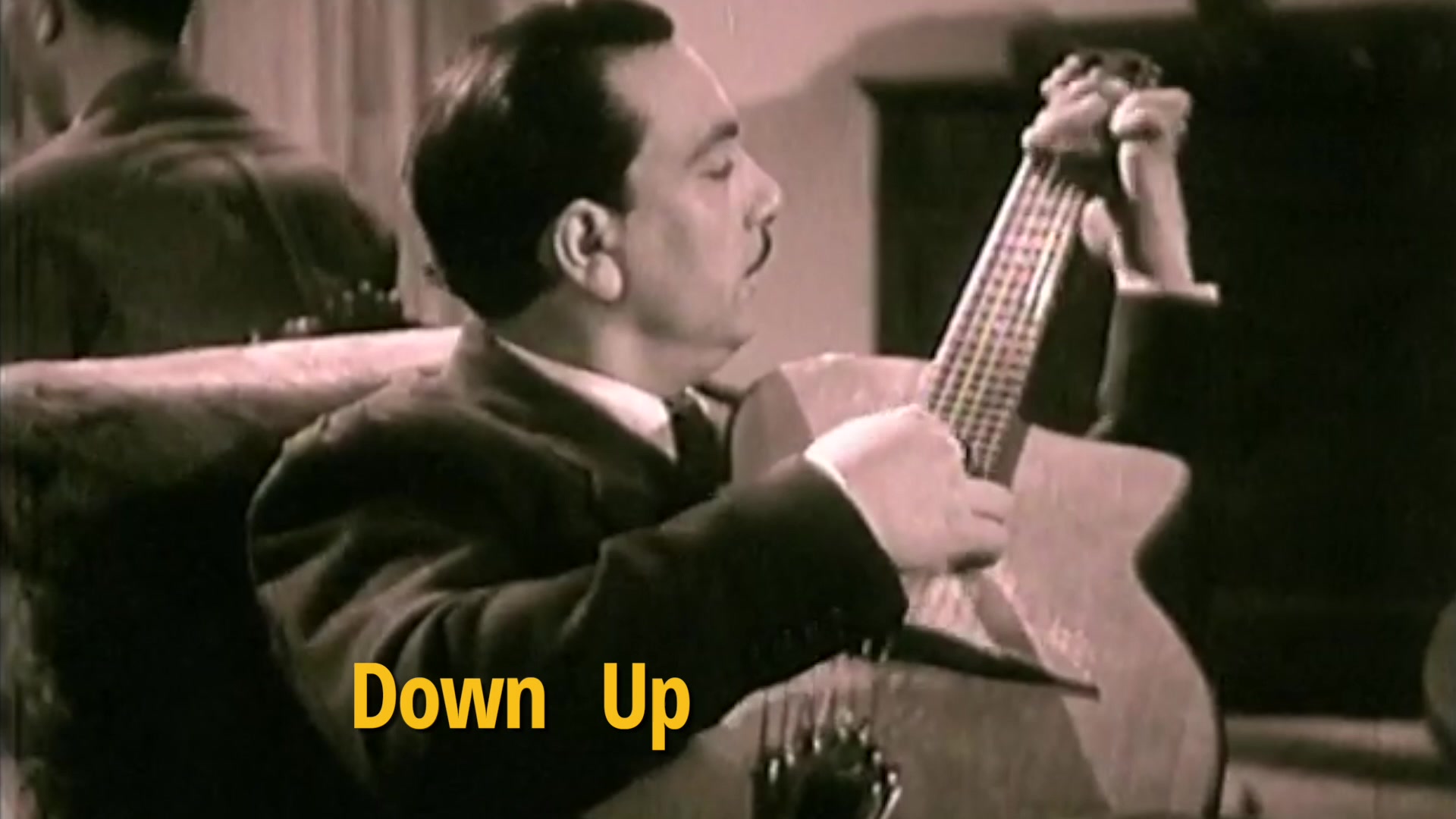
We know from our interview with historian Ben Givan that Django’s signature style emerged soon after his hospital stay from the caravan fire that burned his fretting hand. It’s tempting to speculate that a picking style based on downstrokes and downstroke sweeping that uses Django’s flexed wrist position might have developed while recovering in bed with a picking arm draped over the body of an acoustic guitar. So it is fitting that some of the only known footage of Django’s live playing features him cradling a guitar while reclining on a couch, a playing posture that is not particularly common among guitarists of other picked styles.
Although it seems likely that Django discovered his mechanics on his own, it’s worth noting that popular players of the period like Eddie Lang and Nick Lucas also appeared to use the DWPS economy style. Both players had already found stardom in music and film by the 1920s, before Django developed his mature technique, and would likely have been known to him. Eddie Lang died young, so better footage exists of Nick’s technique, like this television performance on the Lawrence Welk show:
It appears that Nick used almost exclusively downstrokes, for both single note lines and swept phrases, but the blazing arpeggios at the end of the solo are no less impressive for it. It’s not clear what opportunities Django would have had to physically observe the techniques of even very popular players like Nick, but the similarities between his form and Nick’s are obvious, from the supinated arm position, to the wrist flex and downward pickslant. But it’s just as likely that all these approaches flowed from a common popular musical style that emphasized bass-chord downstroke rhythms with downstroke arpeggiation, and Django simply elaborated that style more specifically for lead playing.
Thanks to the efforts of the Gypsy community to systematically teach Django’s mechanics, modern Gypsy virtuosos like Joscho Stephan are remarkably consistent in the application of what we have come to know as “Gypsy Picking”. At its core is USX motion applied to even-numbered note groupings for rapid alternate picking, like this fluid two-note-per-string example from Gypsy virtuoso Joscho Stephan:
And just as in Yngwie and George Benson’s techniques, downstroke sweeping is applied in sonically stealthy fashion even for scalar playing, such as this three-note-per-string example:
Finally, consecutive downstrokes, employing the circular downstroke motion, are used for descending lines whenever USX escaped upstrokes aren’t possible:
In this very common Gypsy application of consecutive downstrokes, the third note on each string uses the circular downstroke motion, so that its upstroke phase avoids the string and doesn’t play a note:

As we can see in slow motion, an alternate picking upstroke is still performed, it’s just not used. In bypassing the string on the way back, picking speed is effectively cut in half. If great Gypsy players like Joscho are able to perform this motion quickly, it’s only because their actual alternate picking speed is very fast to begin with, essentially double the speed of their fastest consecutive downstroke playing.
Thumb Picking
As one explanation for the ubiquity of the DWPS economy system, we can look to what is perhaps the simplest picking technique of all time: thumb technique. When used without a plectrum, the alternate picking motion of the thumb is USX, closely mirroring the Gypsy technique of downstroke rest strokes and escaped upstrokes. Downstroke sweeping is similarly possible by continuing thumb rest strokes through the next string.
The most well-known thumb player in popular guitar is jazz legend Wes Montgomery. His celebrated technique produced remarkably sophisticated fretboard excursions that belied the seeming simplicity of the underlying mechanics:
Upon closer inspection we shouldn’t be too surprised by Wes’ agile soloing, since his thumb technique possesses most of the advantages of pick-based DWPS economy playing. In this overhead closeup of his right hand, the intricate interplay of alternate, sweep, and consecutive downstroke techniques is plainly evident:
The first statement of this brief excerpt is an excellent demonstration of the similarities between thumb and pick DWPS economy execution:

This textbook example of downstroke economy uses sweeping to connect a single note on the A string to three alternate picked notes on the D string and an another single note on the G string. This is essentially two stacked instances of DDU across adjacent pairs of strings, so it’s broadly similar to how a Gypsy player or even Yngwie Malmsteen might handle a similar fretboard arrangement.
In total, Wes’ technique relied more heavily on consecutive downstrokes than Gypsy technique or even George Benson’s approach, though less than the technique of Nick Lucas, who appeared to be almost entirely reliant on downstrokes and downstroke sweeping. The commonality of all these approaches, whether implemented with a pick or a finger, speaks to the universality, simplicity, and overall “guitaristic” nature of the DWPS economy system.
